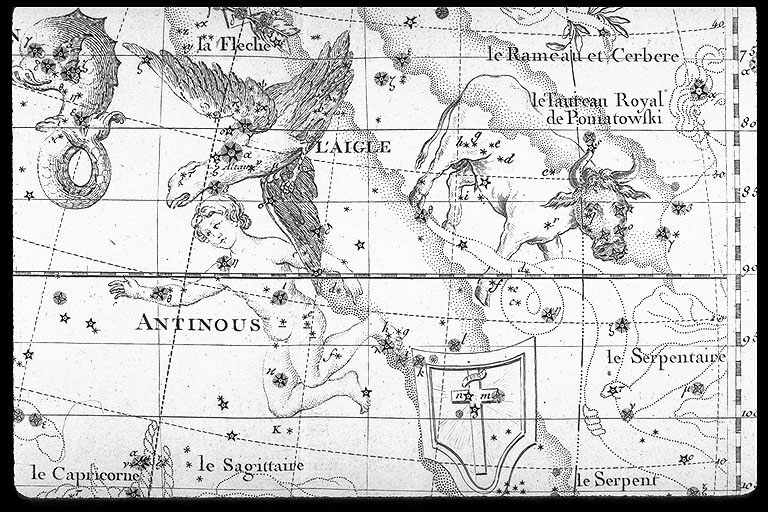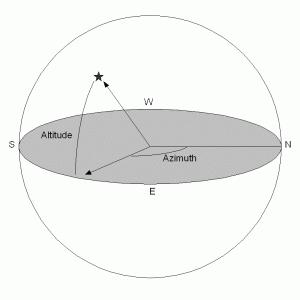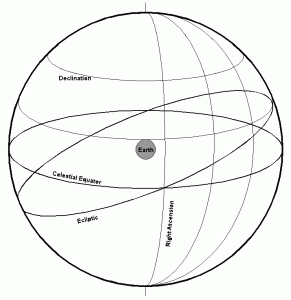
How do astronomers find anything in the night sky? At first, constellations were used to identify regions of the sky, but now astronomers use various coordinate systems to be more precise.
(Photo courtesy of NASA)
Learning Objectives:
- Explain what diurnal and seasonal motions are, and what causes them.
- State what constellations are and how they’re used.
- Define the coordinates of Altitude and Azimuth, and state how they are best used.
- Define the coordinates of Right Ascension and Declination, and state how they are best used.
Equipment:
- Starfinder Wheel
- Constellation Chart
- Ruler
- Computer Planetarium Program
Introduction:
Finding one’s way around the night sky can be tricky at first. Part of the problem is that the night sky isn’t static, it’s always moving. If you go outside and look at the night sky at 10:00pm, it will appear different when you go look again later that night at 2:00am. If you were to go out and look at 10:00pm three months later, it would look different again. Before learning now to find our way around the night sky, we should first learn why it appears to move around.
The apparent motion of the stars across the sky from night-to-night and month-to-month are due not to the actual motion of the stars, but to the motion of the Earth. There are two basic motions that the Earth performs that affect how we see the night sky over a short time-scale. Those two motions are the rotation of the Earth about its axis, and its revolution around the Sun. The rotation of the Earth results in the daily rising and setting of the Sun, Moon, stars and planets which is called diurnal motion. The revolution of the Earth is what causes different constellations to be visible at different times of the year. This is called seasonal motion.

Finding objects in the sky can be tricky. That’s why there are a number of systems for remembering where things are. The simplest, but least precise method is by using constellations. Constellations are simply easily recognizable patterns of bright stars. Every ancient civilization came up with their own set of constellations. The 88 constellations we use today came from the Greeks. Constellations can only describe large regions of the sky; they can’t pinpoint an objects location. One can say, for instance, that Mars is in the constellation of Gemini, and that will help a person know roughly where to look, but you couldn’t use it for pointing a telescope precisely.
To point at an object in the sky precisely, one can use the coordinates of altitude and azimuth. The altitude of an object is simply the angular height of the object above the horizon. Something right on the horizon has an altitude of zero, and something directly overhead, or at the zenith, has an altitude of 90 degrees. Azimuth is the angular position of the object clockwise from due north. Something that is exactly due north has an azimuth of zero, and something with an azimuth of 225 degrees is in the south-southwest. This coordinate system, sometimes referred to as “alt-az,” is fixed to one’s local horizon, so as the night goes by and objects move from east to west, their altitude and azimuth change. For this reason, the alt-az coordinate system is fine for locating objects immediately relative to your local horizon, but it is insufficient for any other time or location. Figure 1 shows a diagram of the alt-az coordinate system.

Defining right ascension is more difficult. The RA measures a star’s location east or west in the sky, making it very similar to the terrestrial coordinate of longitude. The starting point for longitude of Greenwich, England was a purely political one. The starting point for RA is more objective since there is another line of reference that can be used in the sky that is not present on the Earth’s surface. The path of the Sun across the sky is called the Ecliptic. The ecliptic is tilted relative to the celestial equator by 23.5 degrees because of the tilt of Earth’s rotational axis. The point where the Sun crosses the celestial equator on its way northward is the starting point for the celestial coordinate of right ascension. The units of RA are different than for longitude. Longitude is measured in degrees, but RA is measured in hours with 24 hours in the full circle of the sky. Figure 2 shows a diagram of the Celestial Sphere, the coordinates of right ascension and declination, and the ecliptic.
Procedure:
Using the Star Wheel
The Star Wheel is a simple hand-held planetarium. With it you can get a rough idea of where various constellations and bright stars will appear at any time of day on any day of the year. Simply align the date found on the inner ring, with the time found on the outer ring for the day and time you wish to observe. The edge of the window represents the horizon, zenith (overhead) is in the middle of the window, and the rivet represents the North Star, Polaris. Use the Star Wheel to answer the following questions, and record your answers on the data sheet.
- Set the Star Wheel date and time for September 1st9:00pm, and locate the star Vega. Where in the sky is Vega?
- In what constellation is Vega?
- Locate the star Antares. Where in the sky is Antares at 9:00pm?
- To find out when Antares sets, rotate the Star Wheel until Antares sits right on the western horizon. What time lines up with September 1st? This corresponds to the setting time for Antares.
- Now find when Vega will set.
- At what time did Vega rise? Do this by positioning Vega on the eastern horizon.
- What time does Antares rise?
- Now determine the total amount of time that Vega and Antares are above the horizon. You should notice a significant difference. Why are the two times different?
- Some stars and constellations never set below the horizon, these are called circumpolar. Identify three circumpolar constellations.
Using Desktop Planetarium Software
Starry Night is a computer program that simulates the night sky. Although Starry Night is a retail piece of software, there are shareware, open-source programs, and web applets that perform the same basic functions. The software we use here provides greater flexibility and function than these free products, although we will not take advantage of those functions here.
- Start the Starry Night program on one of the computers. The first thing you will need to do is to set the correct time and location. The location should be Kansas City, MO, and the time should be September 1st, 9:00pm.
- Set the location by selecting the menu options: Options → Set Location. Kansas City may already be set, so be sure to check first.
- To set the time, first click on the Stop button at the top of the screen. The stop button is the one with the black square, ■. Now click on the month, day, hour, and minute in turn and type in the correct date and time.
- You should now have a view of the night sky that is similar to what you saw with the Star Wheel. Antares should be in the same place as it was with the Star Wheel. Find Antares by either dragging the screen and locating it manually, or you can use the Center feature. Click on the Find tab on the left edge of the screen. Type in “Antares”. A list should appear with the star Antares at the top of it. Double-click on the first item in the list, and the view will move to automatically center Antares in the screen.
- Hover your cursor over Antares and a table of data will appear. Listed will be the rise and set times, the altitude, azimuth, right ascension, and declination. Record these data on your data sheet. The rise and set times should correspond well with the times from the Star Wheel.
- Over time, the altitude and azimuth of a star will change, but the right ascension and declination should stay the same. Knowing the rate of diurnal motion, record your prediction for the new azimuth of Antares for an observing time of 10:00pm.
- Set the time in Starry Night for 10:00pm, find Antares, and hover your cursor over the star. Record the new altitude and azimuth. Did the right ascension and declination change? How close was your estimate of the new azimuth? This estimation works because Antares is close to the horizon and its altitude doesn’t change much. For Vega, this estimation would not work at all since both the altitude and azimuth are changing significantly, but the measured angle across the sky would still be 15 deg per hour.
- Now make a similar prediction of the azimuth of Antares at 9:00pm two weeks later. Record your prediction on the data sheet based on the known rate of seasonal motion.
- Set the time in Starry Night for 9:00pm on September 14th. Find Antares and record the new altitude and azimuth. How does this compare to your estimation?
Using a Constellation Chart
Even with computer programs such as Starry Night, sometimes a paper chart is still preferred. The vertical axis of the chart is declination, and each tick mark represents one degree. The horizontal axis is right ascension, and each tick mark represents five minutes. Notice that the values of right ascension increase from right to left, opposite of a normal graph.
- With the constellation chart, locate Antares and determine its right ascension and declination. Compare these coordinates with the right ascension and declination for Antares from Starry Night.
- Notice on the ecliptic line, there are dates. Find where the Sun is on September 1st and record its right ascension and declination.
- The Sun should be far from Antares and the constellation of Scorpio. This is why Scorpio is visible during the summer and early fall. List three constellations that are not visible at night on September 1st. Generally, any star or constellation within 2 hours of right ascension will not be easily visible at any point during the night.
- If a new comet were discovered at the coordinates RA=3h 42m and DEC=+45.0 deg, in what constellation would it be?
Data Sheet:
Star Wheel
|
Star |
Location |
Constellation |
Rise Time |
Set Time |
Time Visible |
| Vega | |||||
| Antares |
Why is Vega above the horizon longer than Antares?
List three circumpolar constellations.
____________________ ____________________ ____________________
Starry Night
|
Date |
Sept. 1st, 9:00pm |
Sept. 1st, 10:00pm |
Sept. 14th, 9:00pm |
| Rise Time | |||
| Set Time | |||
| Time Above Horizon | |||
| Predicted Azimuth | |||
| Altitude | |||
| Azimuth | |||
| Right Ascension | |||
| Declination |
Constellation Chart
Antares: ra = __________, dec = __________
Sun on 9/1: ra = __________, dec = __________
Name three constellations that are hidden by the glare of the Sun.
____________________ ____________________ ____________________
In what constellation is the newly discovered comet?